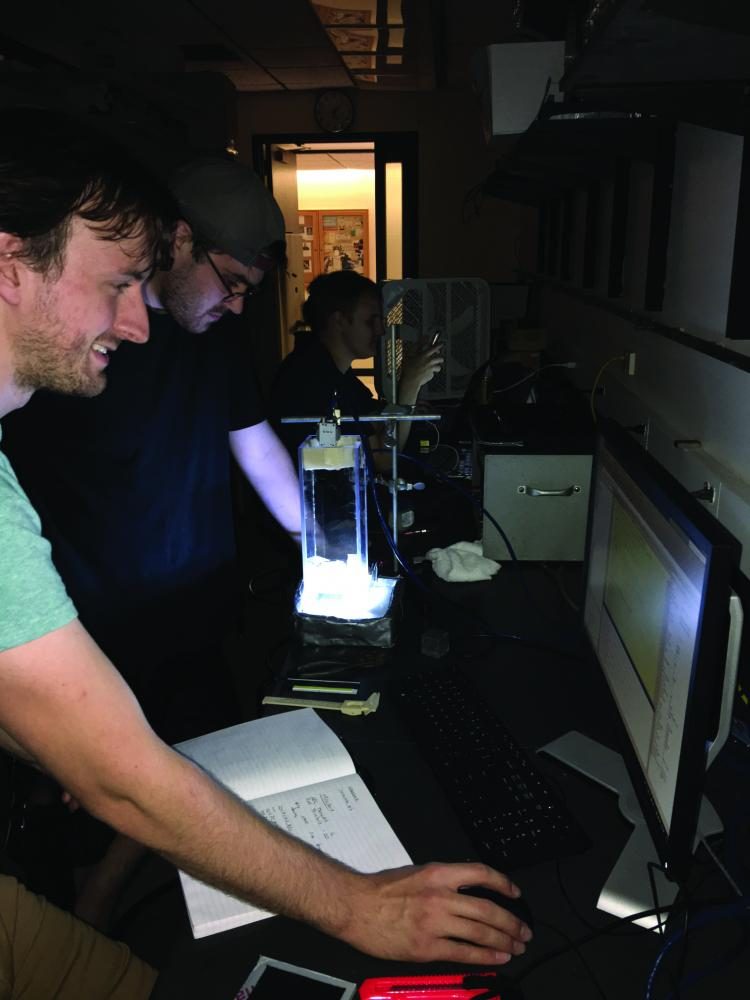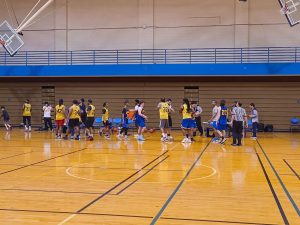The continuing quest on dark matter research
From left to right: Samuel Pate, Patrick Dowdle and Vincent Vangelista. Dr. Orin Harris is going to travel with three students to Canada to research dark matter.
August 22, 2017
An NEIU physics professor is on the continued quest to discover dark matter particles, collaborating with fellow scientists and exposing students to research, all in the same trip.
Assistant professor Dr. Orin Harris will travel with three NEIU undergraduate students to Sudbury, Ontario, Canada to a collaboration meeting composed of international participants such as NEIU and the University of Alberta. Harris gave an explanation as to what constituted dark matter research.
“A birds-eye view is that we think about 80 percent of the matter in the universe is invisible matter,” he said. “We can observe how it affects regular matter with telescopes.”
Science teaches that regular matter is composed of protons, neutrons, electrons, which creates a substance, or substances, that make up a physical object and takes up space.
Dark matter is called “dark” because as opposed to the matter that reflects light, dark matter is invisible and does not reflect anything.
The existence of dark matter is described on picoexperiment.com, where it says it is present in galaxies because of its gravitational pull.
“We’ve never been able to see it in the laboratory because it interacts very, very rarely with regular matter,” Harris said. “We wait, sometimes years, to see if very rarely a dark matter particle deposits energy in our detector,” he said.
Dark matter interacts so rarely with regular matter that experiments to detect it has to occur within labs deep underground.
“Most dark matter experiments have very sensitive detectors,” Harris said. “They are deep underground in order to try and eliminate cosmic rays from reaching them, which would deposit energy in the detectors and make a signal that looks like dark matter.”
Detectors not only have to be below the surface but also have to be in a very quiet environment using a methodology that consists of both superheating and bubble chamber technology.
The methodologies work simultaneously in that bubble chamber technology has a fluid that is kept above its boiling point but due to the nature of its container, it does not boil. The fluid is extremely sensitive to the smallest deposit of energy. Once energy is deposited, it creates a bubble.
“That’s what we’re looking for, a little bubble produced from dark matter depositing,” Harris said. “We have cameras that can photograph the bubbles and another neat part of it is that we have little microphones that can listen to the sound of the bubbles.”
Microphones capture the bubbles that form from different types of particle interactions, which in turn produce different levels of loudness.
“That’s actually one of the primary ways we can distinguish a bubble produced from dark matter from a bubble produced from something more mundane like radioactive decay,” Harris said.
Apart from distinguishing a dark matter bubble, Harris and his students will see it in person.
A clean-room laboratory is located 2 kilometers (approximately 1.24 miles) underground and they will have to take a wide elevator to get there while wearing mining gear. Upon entering the clean-room lab, they will have to shed their mining uniforms and shower.
The bubble chamber is one entity made up of three parts: initially a foot wide, thick, transparent glass vessel filled with superheated liquid, which Harris said is comparable to a 6-foot test tube. The “test tube” is held in a large, steel pressure vessel and both are housed inside a giant vat of water.
“Going deep underground, it’s like one of those amazing life experiences that hopefully will allow them to share that excitement with other students,” Harris said.










Tim G. Meloche • Aug 24, 2017 at 1:24 pm
While everyone is waiting years for answers to dark matter please take some time to review the literature below. There exists a simpler and better solution to so called dark matter.
Since the 1930’s the solution of dark matter is used by academia to explain the galaxy rotation curve of the stars in spiral galaxies. Dark matter has never been observed only inferred ever since; demonstrating of lack of innovation in how gravity works. In order to advance scientific understanding this issue can easily be resolved by learning about the principles of atomic gravity which provide a much simpler and more accurate explanation to the galaxy rotation curve observations.
As always there are vested interests in academic circles to perpetuate the status quo. The challenge is to those who seek solutions and innovation.
The principles of atomic gravity are tools used to unify and advance academic research in the natural sciences. The principles describe the method to how the force of gravity is transferred in both atomic structure and at the galactic scale.
Below are links to google docs that give a summary version to the principles of atomic gravity. It is best if you be the judge in this matter. At the very least it will open the door of discovery and innovation for years to come.
https://docs.com/tim-g–meloche/7280/atomic-gravity?fromAR=1
https://docs.com/tim-g–meloche/4675/zero-g-flight-at-the-atomic-scale?c=ri2tXf